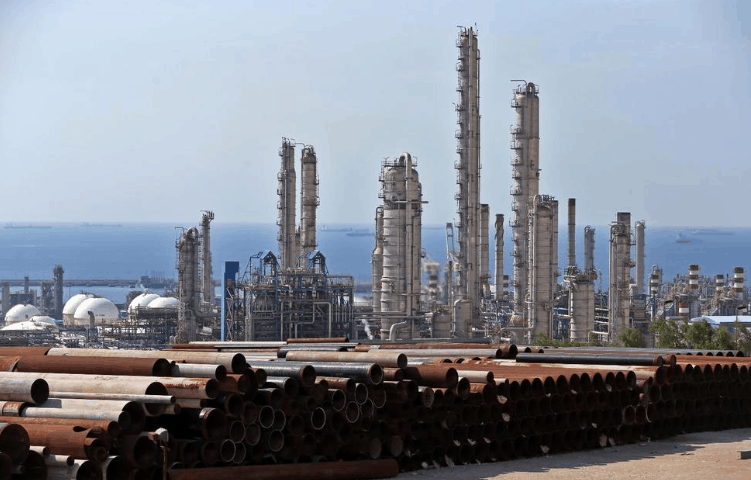The growing supply of crude carries risks for oil markets.
TWO YEARS AFTER IRAN agreed to limit its nuclear ambitions, the Islamic Republic’s oil exports in 2017 climbed as high as 2.1 million barrels per day – not far from peaks achieved in 2005 and 2011.
Yet last month, just nine months after the U.S. reimposed sanctions, those crude exports – at least officially – had plummeted to just 100,000 barrels per day, a drop of 95%.
Iran, hemmed in by strict restrictions on its exports, is pumping huge quantities of oil with virtually nowhere to send them. As a result, it’s sitting on a swelling stockpile of crude that could destabilize markets further, much of it stored in tankers at sea. The product is also being tacitly held in a sanctions gray zone by China, which since January has reportedly received as much as 14 million barrels of Iranian crude but has held off on clearing the commodity through customs to avoid running afoul of international sanctions.
“This represents about one day’s turnover for their refineries,” Kopits says. “It’s not nothing, but not the end of the world, either.”
Any move to draw on those stockpiles would nonetheless have an impact on oil markets already jittery about a potential oversupply of crude. Complicating oversupply concerns are the U.S.-China trade war and warning signs of a looming global recession that could limit demand amid the glut in the oil market. While some experts disagree whether markets are awash in too much oil, investors in recent months have remained almost entirely preoccupied by a potential sudden dropoff in demand.
As recently as Thursday, the price of Brent crude oil – the benchmark for global oil prices and the bellwether for U.S. gasoline – collapsed 7% in a matter of hours after President Donald Trump announced new tariffs on China, dashing investors’ hopes for an end to the trade imbroglio.
“Right now, the oil market is much more concerned with demand and the global macroeconomic situation than it is with supply,” says Ellen Wald, president of Transversal Consulting and a senior fellow at the Atlantic Council Global Energy Center.
Just 15 years ago, even a hint of a potential kink in global oil networks would have sent prices higher, but dwindling output in Venezuela and Mexico, unrest in Libya, and even the downing of an American military drone over the Strait of Hormuz have barely made an impression on benchmark prices.
By comparison, while prices have only barely budged upward, if China were to suddenly throw open the valves on its Iranian oil supply, benchmark prices could fall as much as $7 – an 11% drop from the $62 that Brent was fetching late Friday morning.
Most analysts, though, are doubtful that such a steep decline will occur.
“If we assumed China drew these inventories over three months, that’s about 150,000 bpd. That might keep prices soft, but perhaps by only $1-2 / barrel,” Kopits writes in an email.
Iran in the meantime is expected to draw down its output. But it can’t immediately shut down production without risk of damaging its wells.
“Shutting in the production takes some time, and there are geological considerations,” says Steven Kopits, managing director of Princeton Energy Advisors. “There is probably some continuing production until they absorb the whole embargo, so it wouldn’t be particularly surprising that, for some period of time, there would be inventory builds in Iran.”
And if and when sanctions do lift, Iran has demonstrated that it can rapidly ramp up production. When sanctions were ended in 2015, the country quickly outpaced investors’ and analysts’ expectations for bringing its production back online and resuming exports – developments that modestly suppressed benchmark prices that at the time were already reaching bargain-basement lows amid breakneck production from OPEC and the U.S. Wald, of the Atlantic Council, says that the effect would likely be the same the second time around – though any resolution to the U.S.-Iran impasse remains far beyond the horizon.
“If sanctions were lifted tomorrow and that oil hit the market, it would probably push oil prices lower, but the effect wouldn’t be that significant,” Wald says.
Any resolution to the U.S.-Iran impasse for now remains far beyond the horizon. And with hard-liners in Tehran apparently dictating policy, a more belligerent response – in the face of tightening export controls from the U.S. – is always possible, with considerable implications for oil markets.
“One of the downsides of putting Iran into so much of the squeeze that they’re in now is that Iran may feel that they have nothing to lose by closing the Strait of Hormuz,” Kopits says. “That’s the huge risk if they say, ‘Well, if we can’t export, then no one will export.’ I don’t think we’ve finished seeing issues there.”

